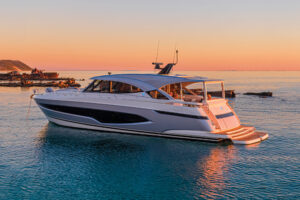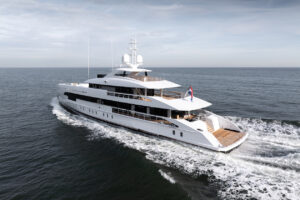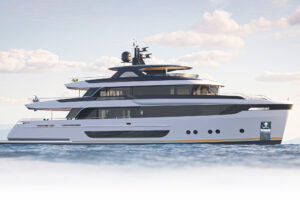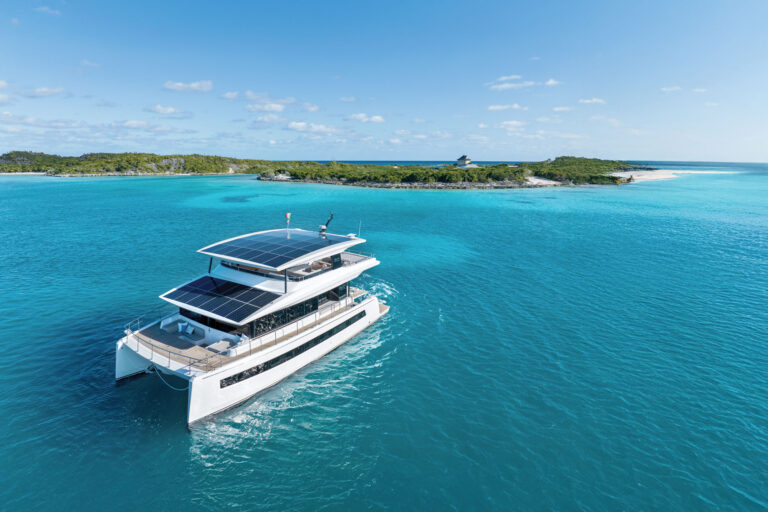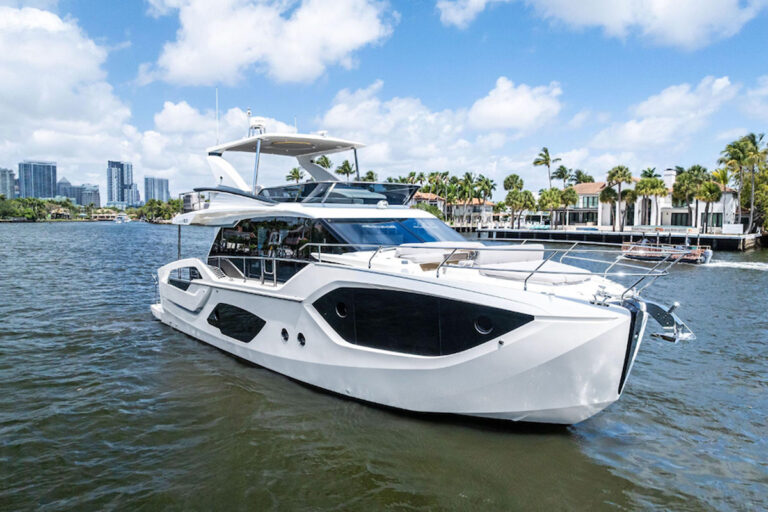Riviera started building boats in Australia almost 20 years ago. Before thinking globally was fashionable, the company focused its efforts on export. Today, most of the 300 or so boats Riviera builds are shipped to 22 countries. The United States has always been an important market for Riviera, and in recent years the nameplate has become common on American waters.
The 40 Convertible fits neatly in the company’s lineup between its 36- and 43-foot convertibles, but her new look dates these other offerings. Like her predecessors, she takes her styling cues from a blend of successful convertible designs. While some might consider this approach unimaginative, it is the nature of the fish boat design business in America, and the 40 is designed for the American market. Riviera refined this input and created one of the best-looking convertibles in its class. Her smooth S-sheer and rakish house are ideally proportioned and do not look overstuffed. Most important, she is designed with a focus on fishing, an important criterion for most convertible owners.
Her cockpit has a molded-in tackle center with sink and chill box/freezer. Future boats will also have tackle drawers. An optional live well is molded into the transom and fitted with a view port. A fish/stowage box beneath the cockpit sole is plumbed with a macerator. There is additional space in the lazarette for line and fender stowage. A teak cockpit sole is an option, as is structural support for a fighting chair. Some other builders include the latter as standard, as Riviera perhaps should, since the 40 is meant to fish.
The 40’s cockpit has a unique self-bailing design. Water collects in channels along the sole’s perimeter and is dispensed through a rather large port hidden beneath the swim platform. A flapper valve prevents water from entering the cockpit while backing down. The transom door opens into the cockpit, which is contrary to American convention. This seems an awkward arrangement and could be a problem for those who boat large fish. An outboard opening door is optional. A phone-style hot/cold cockpit shower is thoughtfully included.
Foredeck access is comfortable thanks to a well-placed bow rail and grab rails on the bridge side. The integral bow pulpit is designed with an anchor shoot. An electric windlass and anchor washdown system are standard. The self-draining ground tackle locker is accessible from the foredeck.
The bridge is laid out with helm and companion pedestal seating, positioned to provide a good view of the cockpit. Also present are bench seating, a sink and space for a refrigerator. The sculptured ergonomic helm console and angled wheel position are express cruiser-like in design and a shift away from the boxy, traditional tournament helm. While the angled wheel at first seemed a bit awkward, I eventually found it comfortable sitting or standing. The console is designed to accommodate a radar, a sounder and a few other odds and ends. There is a molded-in radio box in the optional fiberglass hardtop. Access to the flying bridge is from the cockpit through the overhang.
Because of her 14-foot, 11-inch beam, the 40’s interior layout is larger than you might expect for a boat her length. The excellent saloon arrangement includes an L-shape settee and table. Stowage beneath the settee is suitable for fishing rods. There is space for an ice maker. A built-in TV is forward, adjacent to the L-shape dinette. Owners can choose fixed or opening side windows in the saloon. Windows in the house face are offered, as is an interior helm station. The dinette is sacrificed for the latter.
The galley is a step down from the saloon area and has a refrigerator/freezer, a cooktop, a microwave/convection oven and a dishwasher. I would substitute the dishwasher for the additional drawer space offered as an option. The guest stateroom has upper and lower berths, and a third berth. There is space for a washer/dryer. The master stateroom is forward, with an island berth and innerspring mattress. The stateroom has direct access to the head, which is also accessible from the passageway.
The 40’s interior fit and finish is simple, yet well executed. A variety of interior décor packages complement the high-gloss teak joinery.
Her hull and superstructure are built in female tooling with handlaid woven roving and stitched multidirectional fiberglass reinforcement. The hull bottom and topsides are solid glass, and the superstructure and decks are cored. A network of foam-filled fiberglass stringers supports the bottom and serves as a foundation for the engines. Forward, cavities between the stringers are filled with foam to stiffen the bottom panels. Marine plywood structural bulkheads are fiberglassed in place.
Riviera uses a modular tooling system. A series of interior fiberglass liners are bonded to the superstructure, then lowered into and bonded to the hull. The hull-deck joint is mechanically fastened and bonded with fiberglass. This process creates a strong, stiff structure. The 40’s bilges are finished with gelcoat and smooth to the touch.
Access to the machinery space is from the cockpit. While this is far more desirable than saloon access, it is a bit of a trick on smaller convertible designs. As a result, one must be somewhat limber to enter the engineroom, and captains with a full beam will find things a bit tight inside. Machinery removal hatches are provided.
Systems are tidy and appear sensibly arranged. Engine exhaust is plumbed to hearty, molded fiberglass water lift-style mufflers that funnel exhaust water and gas aft through fiberglass exhaust tubes. Fuel is carried in a fiberglass fuel tank under the cockpit. An optional 160-gallon tank can be added beneath the galley.
Our speed trials were conducted in the calm waters of the Intracoastal near Riviera’s largest dealer, South Florida Yacht Sales in Riviera Beach, but I could not resist taking the 40 out Lake Worth inlet. The seas were running about 4 feet, and the 40 consumed them to deliver a dry, comfortable ride. She twisted and backed with vigor, and she got up and went with neither protest nor clouds of black smoke. The sound levels we recorded were relatively low compared with those of similar boats.
Fitted with 450 hp Cummins, full electronics, a hardtop and an isinglass enclosure, our test boat was $490,000. The price included air conditioning, a 10kW generator and a variety of interior décor accessories. In all, a good boat offered at a competitive price.
The Riviera 40 Convertible is worth considering. While the company’s designs have a pleasingly familiar look, they are unique in finish and outfitting. Riviera focuses on the basics that make good fishing boats good cruising boats-with minimum compromise.
Contact: Riviera, www.rivierayachts.com.

